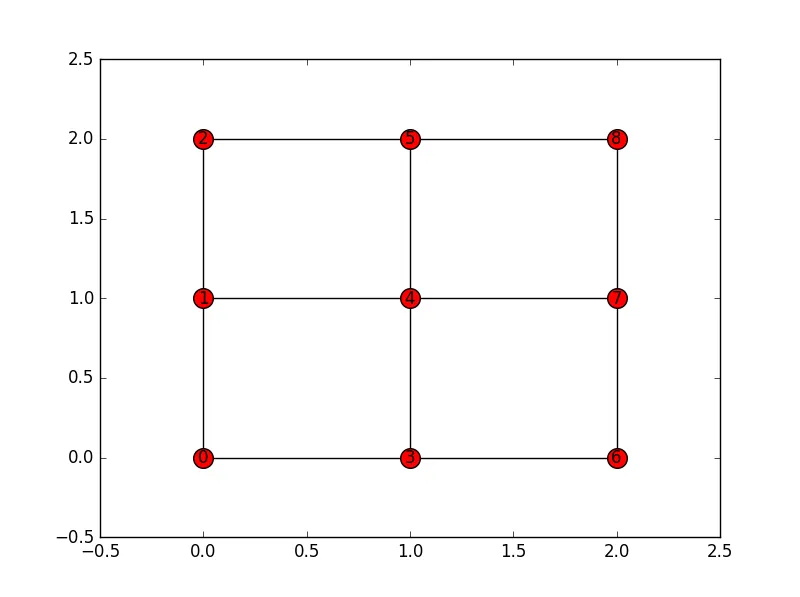我有两种方法可以生成网络的邻接矩阵:
例如:一个
这是可视化效果: 使用
使用
根据它所说,节点
现在是我的代码(要在与上述相同的脚本中运行):
这将产生以下结果:
nx.adjacency_matrix() 和我自己写的代码。我想测试一下我的代码是否正确,但结果出现了一些奇怪的不等式。例如:一个
3x3的晶格网络。import networkx as nx
N=3
G=nx.grid_2d_graph(N,N)
pos = dict( (n, n) for n in G.nodes() )
labels = dict( ((i,j), i + (N-1-j) * N ) for i, j in G.nodes() )
nx.relabel_nodes(G,labels,False)
inds=labels.keys()
vals=labels.values()
inds.sort()
vals.sort()
pos2=dict(zip(vals,inds))
plt.figure()
nx.draw_networkx(G, pos=pos2, with_labels=True, node_size = 200)
这是可视化效果:
 使用
使用 nx.adjacency_matrix() 得到的邻接矩阵:B=nx.adjacency_matrix(G)
B1=B.todense()
[[0 0 0 0 0 1 0 0 1]
[0 0 0 1 0 1 0 0 0]
[0 0 0 1 0 1 0 1 1]
[0 1 1 0 0 0 1 0 0]
[0 0 0 0 0 0 0 1 1]
[1 1 1 0 0 0 0 0 0]
[0 0 0 1 0 0 0 1 0]
[0 0 1 0 1 0 1 0 0]
[1 0 1 0 1 0 0 0 0]]
根据它所说,节点
0(整个第一行和整个第一列)连接到节点 5 和 8。但是,如果您查看上面的图像,这是错误的,因为它连接到节点 1 和 3。现在是我的代码(要在与上述相同的脚本中运行):
import numpy
import math
P=3
def nodes_connected(i, j):
try:
if i in G.neighbors(j):
return 1
except nx.NetworkXError:
return False
A=numpy.zeros((P*P,P*P))
for i in range(0,P*P,1):
for j in range(0,P*P,1):
if i not in G.nodes():
A[i][:]=0
A[:][i]=0
elif i in G.nodes():
A[i][j]=nodes_connected(i,j)
A[j][i]=A[i][j]
for i in range(0,P*P,1):
for j in range(0,P*P,1):
if math.isnan(A[i][j]):
A[i][j]=0
print(A)
这将产生以下结果:
[[ 0. 1. 0. 1. 0. 0. 0. 0. 0.]
[ 1. 0. 1. 0. 1. 0. 0. 0. 0.]
[ 0. 1. 0. 0. 0. 1. 0. 0. 0.]
[ 1. 0. 0. 0. 1. 0. 1. 0. 0.]
[ 0. 1. 0. 1. 0. 1. 0. 1. 0.]
[ 0. 0. 1. 0. 1. 0. 0. 0. 1.]
[ 0. 0. 0. 1. 0. 0. 0. 1. 0.]
[ 0. 0. 0. 0. 1. 0. 1. 0. 1.]
[ 0. 0. 0. 0. 0. 1. 0. 1. 0.]]
以下内容描述了节点0与节点1和节点3的连接情况。为什么存在这样的差异?在这种情况下出了什么问题?
dict的地方,您应该更改为使用collections.OrderedDict... - Corley Brigman